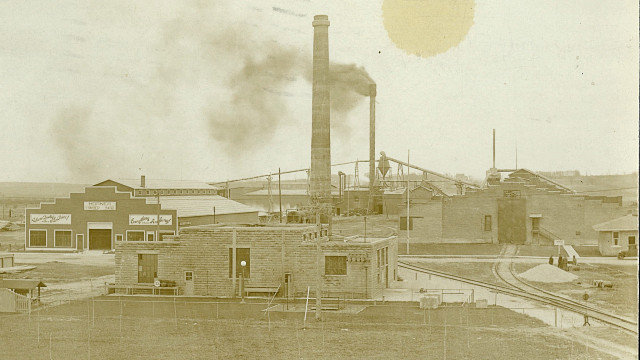By Sterling McGinn
Newberry was widely known for producing a number of products decades ago. Namely celery, lumber, and Pig Iron, which was shipped out by train destined to locations all over the county.
But from 1914 until around 1919, the William Horner Flooring Company was the largest manufacturer of hardwood flooring stock in the United States. And it was located here in Newberry.
From 1914 to 1946 Newberry was a hub for manufacturing hardwood flooring. The flooring plant occupied a good portion of land in the Village of Newberry on East McMillan Avenue between the Parmalee Street and Charles Road intersections, now property of the Village of Newberry.
William Horner, originator of the Newberry plant, first established a planing mill to produce maple flooring in Reed City, Michigan in 1891. His business grew over the next few years.
In 1910, Horner’s company was wiped out by a fire. His Reed City facility was rebuilt with brick and steel, and he was noted for having one of the most modern plants. In 1914, the Reed City dry kilns burned and rebuilt.
Also in 1914 was the construction of the Newberry hardwood flooring manufacturing plant. Albert Abendroth, a longtime employee of William Horner, was tasked with building the new facility in Newberry. He managed the operations for five years until moving to Rhinelander, Wisconsin to start the Robbins Flooring Company.
The Horners brought several families to town in 1914, including the families of George McMullen, Edward Lavender, and Ernest Havens. During the 1920s, the Joseph Villemure family came to Newberry where he managed the plant as well as Frank Ennis, who took the position of office manager.
Newberry’s mill conglomerate consisted of a flooring factory, sawmill and retail lumber yard. There were also company houses constructed along Parmalee Street. The Horner office was built near the railroad track at Parmalee Street and McMillan Avenue. That building is now home to the Village of Newberry offices.
The flooring factory building was very big. It was large enough to that railroad cars were pushed into the building to be loaded with finished flooring.
During the first World War, many of the workers, who were all male, joined the military. During the war, the company hired close to twenty Newberry women to work at the factory. There were also times where the company was contracted to provide power to the village.
By 1919, oak manufacturing started in the south and overtook Horner Flooring’s production.
In 1921, the William Horner Flooring Company went into receivership. Grand Rapids Trust Company, receivers-in-bankruptcy, operated the mill from 1921 to 1934.
In May of 1927, a blaze consumed three dry kilns, the cooling room, and 700,000 feet of hardwood lumber. The damaged infrastructure was rebuilt.
The company was sold at auction to Robbins Flooring Company in July of 1934. Robbins sold the sawmill to Chesbrough Lumber Company, which was operated by Edward Holland and Paul Kirschmyer. That company continued to provide hardwood to Robbins for the flooring.
The retail lumber yard was sold to Frank Klesner and Frank Ennis. Albert Abendroth’s son, Paul, was put in charge of the Newberry Plant. His brother, Walter, ran the Rhinelander plant.
Robbin’s Flooring Mill was one of the largest flooring plants in north-central United States. Though there were small sales of the flooring locally and minimal amounts sold in the Upper Peninsula, daily carloads of their product was shipped by rail to New England, North Carolina, and California.
On January 29, 1937, the flooring plant suffered a second disastrous fire. The building was destroyed. It was immediately rebuilt as fireproof as possible with a state-of-the-art sprinkler system. This fire also prompted the construct Newberry’s first water tower for added fire protection in the village.
Robbins Flooring Mill was in operation again exactly one year after the fire. Because the company decided to rebuild, and because of its’ substantial contribution to the town, the community honored the Abendroths with a jubilee banquet on January 11, 1938.
According to a Sault Evening News article from January 13, 1938, “The Abendroths—Paul and Walter—were honored at a reception banquet attended by more than 100 Newberry businessmen, held in the community building Tuesday evening in celebration of the reopening of their hardwood flooring plant here.”
Newberry continued to be a center of hardwood flooring manufacturing until 1946, when Robbins Flooring Company moved out. The plant was sold to Atlas General Industries.
Horner Lumber Yards continued selling retail lumber of out their warehouse with a slogan of “Everything to Build Anything.”
Newberry’s Atlas Plywood Corporation plant was, at one time, one of the 22 mills owned by that corporation with locations across the country. The plant manufactured plywood, cleating and packing cases.
Atlas operated in Newberry until 1962. The mill yards and buildings reverted to ownership by the village, laying idle until 1971. The facility was sold to Newberry Wood Products Corporation in 1972, and that business operated for a few years later. Heller and Heller, who financed in part with Newberry Wood Products, took ownership of the facility.
After negotiating with the Luce County EDC, Tahquamenon Wood Products leased the north portion of the plant until a disastrous fire destroyed the facility in January of 1978—the third time the facility was destroyed.
The site became a brown field and is now home to Atlas Park. The park is named for the plywood plant which operated there for 16 years.
The Horner and Robbins companies are still manufacturing hardwood flooring. The Horner Sports Flooring Company mill operates in Dollar Bay, Michigan, and they manufacture flooring that has been used in the NBA, NCAA, and for Olympic games.
Robbins still has manufacturing operations in Wisconsin and Michigan.











